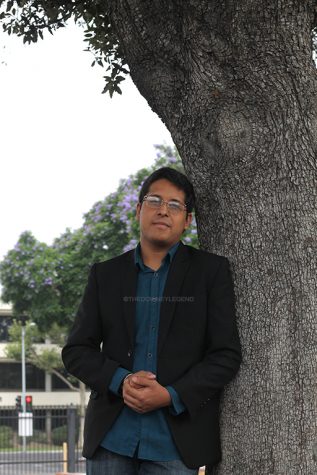Score of the Week: The Shape of Water by Alexandre Desplat
January 31, 2018
“For it seems to me that when we speak of love – when we believe in love – we do so in a hopeless way. We fear looking disingenuous. But Love is real – absolutely real – and, like water, it is the most gentle and most powerful force in the Universe. It is free and formless until it pours into its recipient, until we let it in. Our eyes are blind, but our soul is not. It recognizes love in whatever shape it comes to us.” – Guillermo Del Toro at the Venice Film Festival, 2017
Water being synonymous with love and vice versa is the heart of Del Toro’s arthouse film, The Shape of Water. Water governs all: water influences the turquoise color scheme equipped to provide an underwater ambience, it influences the creature at the center of the unorthodox fairy-tale, but water/love takes the best shape in the form of music. Alexandre Desplat’s score takes the form of water through a series of woodwind instruments that elicits sensations of resting in warm water. For simplicity’s sake, the score is best divided into two categories: The Sounds of Love and Water and Evil in the Shape of Music.
The Sounds of Love & Water:
A melody begins; the lovely cadence of waves coupled with a distant echo washes over as flutes begin to play and slowly, gently, increase in pitch until the melody arrives at its apex with the accordion playing, quietly. The Shape of Water introduces a warm sensation, almost cathartic in its rhythm, as its titular theme intertwines a love theme with sounds associated with water; the resulting effect is a sense of levity, as if you are floating, roaming, in water with no limitations. It is immediately satisfying and complete, yet the wait for this gentle but powerful melody is long. Desplat’s score carefully lays out the fundamental structure of the film’s principle song, so as to mimic Eliza’s journey to find a love reminiscent of past fairy-tales. Despite opening with an underwater sequence, “A Princess Without a Voice,” the opening theme, features trademarks of the core melody but feels constricted—limited only to the use of piano and a hint of a flute playing—which in turn leads the audience to feel slightly empty. Audiences are then introduced to Eliza, a mute woman that lives a monotonous life, yet possess a certain joie de vivre uncommon in the world she inhabits. “Eliza’s Theme” exemplifies her character by building upon the main theme while introducing a vintage parisian vibe through the use of an accordion and flute.
Subsequent songs in the film follow similar patterns with the exceptions of “The Silence of Love” and “Overflow of Love”. “The Silence of Love” initiates shortly after Eliza’s encounter with the Amazonian creature found by the Americans. Though the song is similar to its counterparts, it introduces a key feature necessary for the main theme: a whistle. Gentle and soft, the whistle serves as Eliza’s only voice – a voice necessary to complete this love story. “Overflow of Love” encapsulates Desplat’s primary motif as the song layers the sounds of all the instruments vital to the score—a piano, cello, violin, flute, and an accordion—at the moment in which Eliza’s relationship with the Amphibian Man climaxes. But even in their beautiful jointship, the relationship is still confined by the strains of the human world.
Realism may have impeded their love, but love always finds a way to surpass all. It isn’t until they are submerged underwater that water, that love, has truly taken shape. “Underwater Kiss” is a return to the titular song: free and loving, tragic yet soothing. It is an amalgamation of Eliza’s journey to find a love unrestrained by the confines of cynicism and perfectionist ideals prevalent in the real world.
Evil in the Shape of Music:
When love blooms, greed and deception follow shortly thereafter. Desplat’s score highlights this pattern as it balances the love story with the Cold War setting of the film. In its initial minutes, the Amphibian Man is introduced to be a mysterious, harmful being to be experimented on. “The Creature” expresses such sentiments with the use of low-pitch tones that breed ideas of an evil entity looming. Thematic elements of duplicity are futhered as the Cold War/spy thriller facet of The Shape of Water unravels; with russian spy meetings being highlighted every so often during the runtime of the film, Desplat changes the meaning of water as it is reformed to make the audience feel isolated and afraid. Two changes helped redefine water: (1) A sonic echo mimicking the sound of a radar; and (2) imploring stronger use of the violin. Both “That isn’t Good” and “Spy Meeting” make use of these motifs to display the evil breeding amidst the fairy-tale that is taking shape. Evil reaches the surface in its most crucial point when the film’s villain, Richard Strickland, grows desperate as the perfect utopia he created for himself begins to crack and fall down on him. “Rainy Day” introduces a dissonant melody that reinforces the anger fueling Strickland in the ending confrontation with Eliza and her allies.
Although hate and anger rooted itself in the world of The Shape of Water, they are not the main focus, and neither are they the main focus of the score. And they are not meant to be. The war between love and hate is one-sided because love always win. Love is a medicine for troubled times – a force that flows through every human being, a force that takes many shapes, whichever that may be.
Tickets for The Shape of Water are available now at Fandango.com. Desplat’s score for the film is available on Spotify, Apple Music, and other music streaming services.



